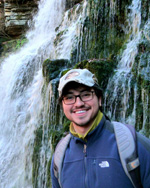
Adrian Cadar
Graudate Student, Molecular Physiology and Biophysics
Mentors:
Dr. Chee Lim (Thesis)
Dr. Jason Becker (Clinical)
The cardiac sarcomere is the basic contractile unit of the heart and is comprised of a large assembly of proteins including contractile proteins actin, myosin, troponins, tropomyosin etc. that are responsible for force generation. Titin (TTN) is a giant protein that essentially acts as the backbone of the sarcomere by serving as a molecular scaffold for many other sarcomeric proteins to organize around. TTN mechanically contributes to the majority of passive cardiomyocyte tension due to the elongation of its spring domain as the sarcomere is stretched above resting length during diastole (ventricular filling). TTN also accounts for most of the restoring force that is derived from its spring domain recoiling when the sarcomere is contracted below resting length during systole. TTN has been shown to be a signalosome contributing to muscle gene expression and turnover with direct interaction of its kinase domain with the Nbr1-p62-MURF2-SRF complex. Deregulation in TTN has been central to many cardiac and musculoskeletal diseases. Taken together TTN plays a critical mechanical as well as signaling role in sarcomere function and maintenance. Even though TTN has been extensively studied, the majority of these studies have focused on its structural and mechanical roles as well as genomic mutations; the transcriptional and post-transcriptional regulation of TTN is virtually unknown. My thesis will address the post-transcriptional processing of TTN and its possible deregulation in context of cardiac disease.
Deregulation in TTN has been central to many cardiac diseases. Recently, 27% of dilated cardiomyopathies are due to a truncated TTN protein. TTN abnormalities have been shown to cause congenital early-onset myopathy, tibial muscular dystrophy, heredity myopathy with respiratory failure. My clinical mentor, Dr. Jason Becker, is a cardiologist specializing in inherited cardiomyopathies and has been instrumental in helping me design translational components to my projects. With him, I have had the opportunity to meet patients with inherited cardiovascular diseases. The clinical perspective has undoubtedly influenced the way I ask and test new questions.